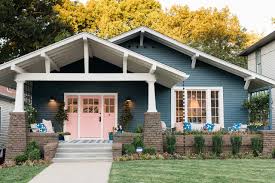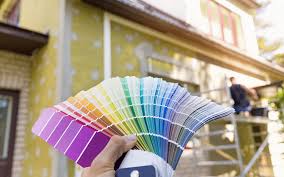Tips For Choosing Exterior Paint Colour
look at the climate that you live in.
If you’re in a hot climate, you’ll want to look at lighter colors, because they absorb much less light and heat, so it’s an energy efficient choice. There’s also the neighborhood you live in, which is a huge factor. Some people live in a neighborhood where an HOA dictates the colors, which is automatically limiting right there. But if you don’t, then look around at the houses in your neighborhood. It’s not that you have to blend in or match your neighbor’s houses — I wouldn’t want people to do that — but you don’t want to veer off too far from the rest of the homes. So if you live in a neighborhood with mostly light colored homes or mostly dark colored homes and especially if you live kind of close to your neighbors, then do let that be a guide. If you’re more spread out and don’t have a lot of close neighbors, then those rules can be loosened a bit. Lastly, I’d say it comes down to colors you like. It’s pretty easy to get to a limited selection if you take all of those into account.

Here are several tips designers and architects use to find exterior colour schemes
The quickest way to spruce up the outside of your home is with new paint colors. Whereas you’re free to choose any colors for the relatively private interior, everyone sees the outside your home, so there’s a public component to your color selection to consider.
1. Pay Attention to Your Neighborhood
Study the color schemes of the homes around you, noting which ones spark your fancy. If your home is similar in style, then a variation on your favorite color schemes will look nice and be appropriate for the neighborhood.
2. Follow the Sun
Full sunlight intensifies colors, so make note of what parts of your home get the most sunlight at which times of day. If the front of your home is in full sun for the second half of the day, consider more subtle colors to avoid a garrish effect. Conversely, a home mostly in soft shade due to trees can sport more saturated colors to beautiful effect.
3. Play with Accents
Homes typically have many smaller details, like shutters, porch columns, fascia, where you can be more adventurous with color. For example, stick with a neutral color for the body of the home, and use one bold color to highlight the front door. Also, remember that you have flower pots (and flowers), home address plates and mailboxes to use as opportunities for pops of bright color.
4. Embrace Contrast
Variations in tones highlight the architectural details of your home, so you need both dark and light colors for visual interest. If the main body of your home is a dark color, go for lighter window frames, shutters and trims to provide contrast.
5. Test Colors on the Home
The color you see on the paint chip in the store will become darker and more intense in full sunlight across a wide swath of the exterior. Make large boards with the paint colors you’re considering so you can move them about the exterior. Or paint the samples directly onto several spots of the home. You want to see the colors at different times of day under different lighting conditions to assure you can live comfortably with those colors.
6. Coordinate with Materials
For homes with a stone or brick façade, choose trim colors that work with the natural shades and textures. For instance, a dark red brick home benefits from a contrasting cream trim with sage green accents as the complimentary color to red.
Exterior paints elements
While you may see your home as one whole item, when it comes to painting, there are many separate items to be considered. If it was all painted one color, your home would look very dull. It’s a good idea to have a house color and an accent color or two to make it stand out. Here are a few elements to consider:
- Siding: Should be your main color focal point.
- Window & Door Trim: Neutral accent colors work best here.
- Front Door: Make your front door pop with color.
- Railings & Spindles: Another area you can play with an accent color or neutral.
- Shutters: While neutral accents work best, some homeowners like to coordinate with their door or trim color here.
Pay attention to scale as it relates to color
The mass of your home determines the range of color choices for your exterior. For example, a very large house in a very dark color might look too imposing; a very small house that’s painted too light might seem floaty in the landscape. This midsize house is a good example of using a single midrange hue in a way that’s complementary without being overpowering. To prevent the front door from getting lost, try painting or staining it in a warm, rich color.

Here are some color trends we are loving
· Black and White
sometimes simpler is better, and a white house paired with black features, including the door, windows and trim, balcony railing and even the gutters truly makes a stand-out showpiece for your neighborhood. The best part about choosing black and white is the ready availability of these colors from most suppliers. Whether it’s black window trim and eavestroughs, or white board-and-batten, like the above Allura fiber cement panels in Snow, these colors are easy to find.
Tone on Tone
Then try using gradients of the same color throughout your home as another way to achieve an updated aesthetic. Older home styles commonly used the same shade from foundation to roofline, but varying your color palette from top to bottom helps freshen up the look. Here, the homeowner has chosen a soft creamy color for the lower siding and pillars, which melds nicely with a soft mid-tone brown on the peaks. Finally, the darkest shade is found in the roof, drawing the eye up, making the house feel taller.
Warm Earth Tones
For a transported feeling, choose warm tones with contrasting trim. Siding in a warm brown tone like Allura’s Ashen makes us think of hot days lounging by the pool or even exploring a vineyard. Bright contrast here comes from white pillars and gutters, and the darker window trim helps the home stand out, even with a paler primary color.
The Blues
When choosing blue, think about how the rest of your home’s trim and roof will look with it. Light trim, like white and cream, can bring a classic country feel, while dark gray and black bring modern drama. Or combine them for something unique, like the image above.
Bold Red
If you’re feeling brave though, red never really goes out of style. Paired with classic white trim and a dark roof, this is a look that will last for decades, while still being unique in almost any neighborhood. Colors like Allura’s Autumn Red will brighten up any street.
Which Will You Choose?
Today’s home trends are all about bringing your unique style to the project. Trends are great, but by taking advantage of design features including your siding, trim, railings and doors, you can go beyond the two-dimensional image in a magazine, into a home that truly reflects your unique style.